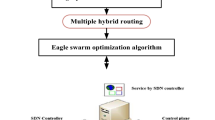Abstract
This paper presents a naked mole rat (NMR) inspired energy efficient protocol for heterogeneous wireless sensor network. NMR uses strategic deployment among three types of nodes i.e. normal nodes, advanced nodes and super nodes. It takes into consideration that nodes near the base station consumes more energy as they have to act as both data originators as well as data router, therefore nodes near the base station have been provided with maximum amount of energy. Moreover, it is seen that normal nodes in heterogeneous network dies out first. So, in order to increase the stability period, advanced nodes have been associated with normal nodes which add to the energy of the normal nodes as advanced nodes don’t participate directly in the communication. Another addition is introduction of new weighted probability based on heterogeneity parameters of network for cluster head selection. Furthermore, a very important energy consumption parameter i.e. energy consumed in sensing has been taken into consideration. The simulation outcomes show that NMR based protocol is more proficient than existing protocols in terms of stability, lifetime and throughput of the network.






Similar content being viewed by others
References
Mathur, P., Nielsen, R. H., Prasad, N. R., & Prasad, R. (2014). Wildlife conservation and rail track monitoring using wireless sensor networks. In 4th international conference on wireless communications, vehicular technology, information theory and aerospace & electronic systems (VITAE). IEEE. https://doi.org/10.1109/VITAE.2014.6934504.
Cuevas, E., Gonzalez, M., Zaldivar, D., Perez-Cisneros, M., & Garcia, G. (2012). An algorithm for global optimization inspired by collective animal behavior. Hindawi Publising Corporation, Discrete Dynamics in Nature and Society. https://doi.org/10.1155/2012/638275.
Bennett, N. C. (2011). Teasing apart socially-induced infertility in non-reproductive female Damaland Mole Rats. Pretoria: Mammal Research Institute, Department of Zoology and Entomology, University of Pretoria.
Burland, T. M., Bennett, N. C., Jarvis, J. U. M., & Faulkes, C. G. (2002). Eusociality in African Mole Rats: New insights from patterns of genetic relatedness in Damaraland Mole-Rats. Proceedings of the Royal Society of London B, 269, 1025–1030. https://doi.org/10.1098/rspb.2002.1978.
Kimchi, T., Reshel, M., & Terkel, J. (2005). Evidence for the use of reflected self-generated seismic waves for spatial orientation in a blind subterranean mammal. The Journal of Experimental Biology, 208, 647–659. https://doi.org/10.1242/jeb.0.1396 (published by the company of Biologists).
Henry, E. C., Dengler-Crish, C. M., & Catania, K. C. (2007). Growing out of a caste-reproduction and the making of the queen mole-rat. The Journal of Experimental Biology, 210, 261–268. https://doi.org/10.1242/jeb.02631 (published by the company of Biologists).
Griffin, A. S. (2008). Naked mole rat. Current Biology, 18(18), R844.
Smaragdakis, G., Matta, I., & Bestavros, A. (2004). SEP: A stable election protocol for clustered heterogeneous wireless sensor networks. Technical report BUCS-TR- 2004-022. In Second international workshop on sensor and actor network protocols and applications (SANPA).
Qing, L., Zhu, Q., & Wang, M. (2006). Design of distributed energy-efficient clustering algorithm for heterogeneous wireless sensor networks. Computer Communications, 29, 2230–2237. https://doi.org/10.1016/j.comcom.2006.02.017.
Singh, S., Malik, A., & Kumar, R. (2017). Energy efficient heterogeneous DEEC protocol for enhancing lifetime in WSNs. Engineering Science and Technology, 20, 345–353. https://doi.org/10.1016/j.jestch.2016.08.009.
Lin, S., & Kernighan, B. W. (1973). An effective heuristic algorithm for travelling salesman problem. Operations Research, 21(2), 498–516.
Dorigo, M. (1991). Ant system: An autocatalytic optimizing process. Technical report 91–016.
Dorigo, M., Maniezzo, V., & Colorni, A. (1996). Ant system: Optimization by a colony of cooperating agents. IEEE Transactions on Systems, Man, and Cybernetics-Part B: Cybernetics, 26(1), 29–41.
Dorigo, M., & Gambardella, L. M. (1997). Ant colonies for the travelling salesman problem. BioSystems, 43, 73–81.
Di Caro, G., & Dorigo, M. (1998). AntNet: Distributed stigmergetic control for communications networks. Journal of Artificial Intelligence Research, 9, 317–365.
Maniezzo, V., & Colorni, A. (1999). The ant system applied to the quadratic assignment problem. IEEE Transactions on Knowledge and Data Engineering, 11(5), 769–778.
Dorigo, M., & Blum, C. (2005). Ant colony optimization theory: A surve. Theoretical Computer Science, 344, 243–278.
Dorigo, M., & Socha, K. (2006). An introduction to ant colony optimization. IRIDIA-technical report series, technical report no. TR/IRIDIA/2006-010, April.
Meisel, M., Pappas, V., & Zhang, L. (2009). A taxonomy of biologically inspired research in computer networking. Computer Networks. https://doi.org/10.1016/j.comnet.2009.08.022.
Changan, L., Xiaohu, Y., Chunyang, L., & Hua, W. (2011). The wolf colony algorithm and its applications. Chinese Journal of Electronics, 20(2), 212–216.
Taherdangkoo, M., Shirzadi, M. H., & Bagheri, M. H. (2012). A novel meta-heuristic algorithm for numerical function optimization: Blind, naked mole-rats (BNMR) algorithm. Scientific Research and Essays, 7(41), 3566–3583. https://doi.org/10.5897/SRE12.514.
Xing, B., & Gao, W.-J. (2014). Innovative computational intelligence: A rough guide to 134 clever algorithms (Vol. 62). London: Springer.
Sandra, S., et al. (2015). Systems and algorithms for wireless sensor networks based on animal and natural behavior. International Journal of Distributed Sensor Networks, 11(3), 625972.
Heinzelman, W. B., Chandrakasan, A. P., & Balakrishnan, H. (2002). An application specific protocol architecture for wireless microsensor networks. IEEE Transaction on Wireless Communication, 1(4), 660–670.
Kumar, D. (2014). Performance analysis of energy efficient clustering protocols for maximising lifetime of wireless sensor networks. IET Wireless Sensor Systems, 4(1), 9–16. https://doi.org/10.1049/iet-wss.2012.0150.
Shelby, Z., Pomalaza-Raez, C., & Haapola, J. (2004). Energy optimization, in multihop wireless embedded and sensor networks, personal, indoor and mobile radio communications. In 15th international symposium. IEEE. https://doi.org/10.1109/PIMC.2004.1370868 (Spain).
Halgamuge, M. N. (2006). Performance evaluation and enhancement of mobile and sensor networks. Ph.D Dissertation, University of Melbourne, Australia.
Kour, H., & Sharma, A. K. (2010). Hybrid energy efficient distributed protocol for heterogeneous wireless sensor network. International Journal of Computer Applications, 4(6), 1–5.
Author information
Authors and Affiliations
Corresponding author
Rights and permissions
About this article
Cite this article
Nehra, V., Sharma, A.K. & Tripathi, R.K. NMR inspired energy efficient protocol for heterogeneous wireless sensor network. Wireless Netw 25, 3689–3700 (2019). https://doi.org/10.1007/s11276-019-01963-2
Published:
Issue Date:
DOI: https://doi.org/10.1007/s11276-019-01963-2




